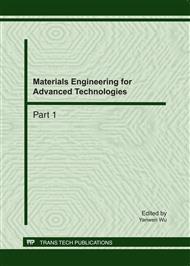p.335
p.341
p.347
p.352
p.357
p.363
p.369
p.375
p.381
Effect of Substrate Concentrations of the BZ Reaction on Period of Self-Oscillation for Non-Thermoresponsive Polymer Chain
Abstract:
In this study, effect of the initial substrate concentrations of the Belouzov-Zhabotinsky (BZ) on a period and transmittance self-oscillating behavior for a polymer chain were investigated under the constant temperature condition (T = 20 °C). The polymer chain was composed of a non-thermoresponsive poly-vinylpyrrolidone (PVP) main-chain covalently-bonded to the 10 wt% ruthenium catalyst (Ru(bpy)3) of the BZ reaction. The transmittance self-oscillation originates from the different solubility of the Ru catalyst moiety in the reduced and oxidized state. The waveform and period of the non-thermoresponsive polymer chain was significantly affected by the initial concentration of the BZ substrates. Moreover, as the concentration of the Ru catalyst increased due to the increase in the polymer concentration, the period hardly changed because of the high solution viscosity.
Info:
Periodical:
Pages:
357-362
Citation:
Online since:
June 2011
Authors:
Keywords:
Price:
Сopyright:
© 2011 Trans Tech Publications Ltd. All Rights Reserved
Share:
Citation:


